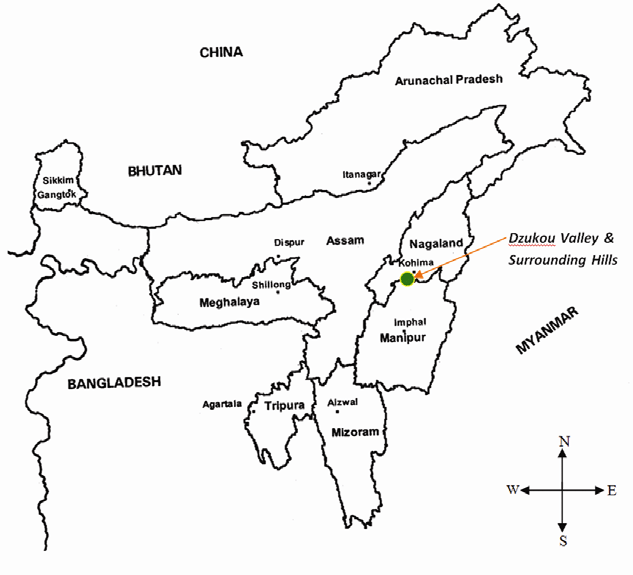Biodiversity & Environment
Dzukou Valley
- 13 Jan 2021
- 4 min read
Why in News
The two-week long forest fire in Dzukou valley on Nagaland-Manipur border has been doused.
- The 90-sq km green valley has been prone to forest fires for decades - in 2015, 2012, 2010 and 2006.
Key Points
- Location: The Dzukou Valley, popularly known as the ‘valley of flower’, is located at the border of Nagaland and Manipur.
- Features:
- Situated at an altitude of 2,438 metres behind the Japfu mountain range, it is one of the most popular trekking spots in the North East.
- Dzukou valley and Japfu peak are located adjacent to the Pulie Badze Wildlife Sanctuary (Nagaland).
- There are no human habitations within the forests, but they are home to rare and ‘vulnerable’ (as per the IUCN Red List) birds - Blyth’s Tragopan (Nagaland’s state bird), the Rufous-necked Hornbill and the Dark-rumped Swift, among many others. Also found in the forests are endangered Western Hoolock Gibbons.
- It is covered with bamboo and other grass species. The valley harbours many species of flowering plants including the endemic Dzukou Lily- Lilium chitrangada.
- The valley is a source of conflict for ownership between local tribes and the state governments of Manipur/Nagaland.
- It is home to the Angami people.
- Situated at an altitude of 2,438 metres behind the Japfu mountain range, it is one of the most popular trekking spots in the North East.
Forest Fires
- Description:
- Wildfire, also called forest, bush or vegetation fire, can be described as any uncontrolled and non-prescribed combustion or burning of plants in a natural setting such as a forest, grassland, brush land or tundra, which consumes the natural fuels and spreads based on environmental conditions (e.g., wind, topography).
- Causes:
- Wildfire can be incited by human actions, such as land clearing, extreme drought or in rare cases by lightning.
- One of the major reasons for forest fires in the north-east is slash-and-burn cultivation, commonly called jhoom or jhum cultivation.
- The fires happen between the months of January and March. The north-east has tropical evergreen forests and, unlike the dry deciduous forests of central India, these are not likely to catch fire easily.
- Impact:
- Globally, forest fires release billions of tons of CO2 into the atmosphere, while hundreds of thousands of people are believed to die due to illnesses caused by exposure to smoke from forest fires and other landscape fires.
- Some Findings from the 2019 Report by the Forest Survey of India (FSI):
- About 21.40% of forest cover in India is prone to fires, with forests in the north-eastern region and central India being the most vulnerable.
- While the overall green cover has increased in the country, the forest cover in the north-east — particularly in Mizoram, Arunachal Pradesh and Nagaland — has decreased. Forest Fires could be one of the causes.
- Measures Taken:
- National Action Plan on Forest Fires (NAPFF) 2018
- Forest Fire Prevention and Management Scheme.





